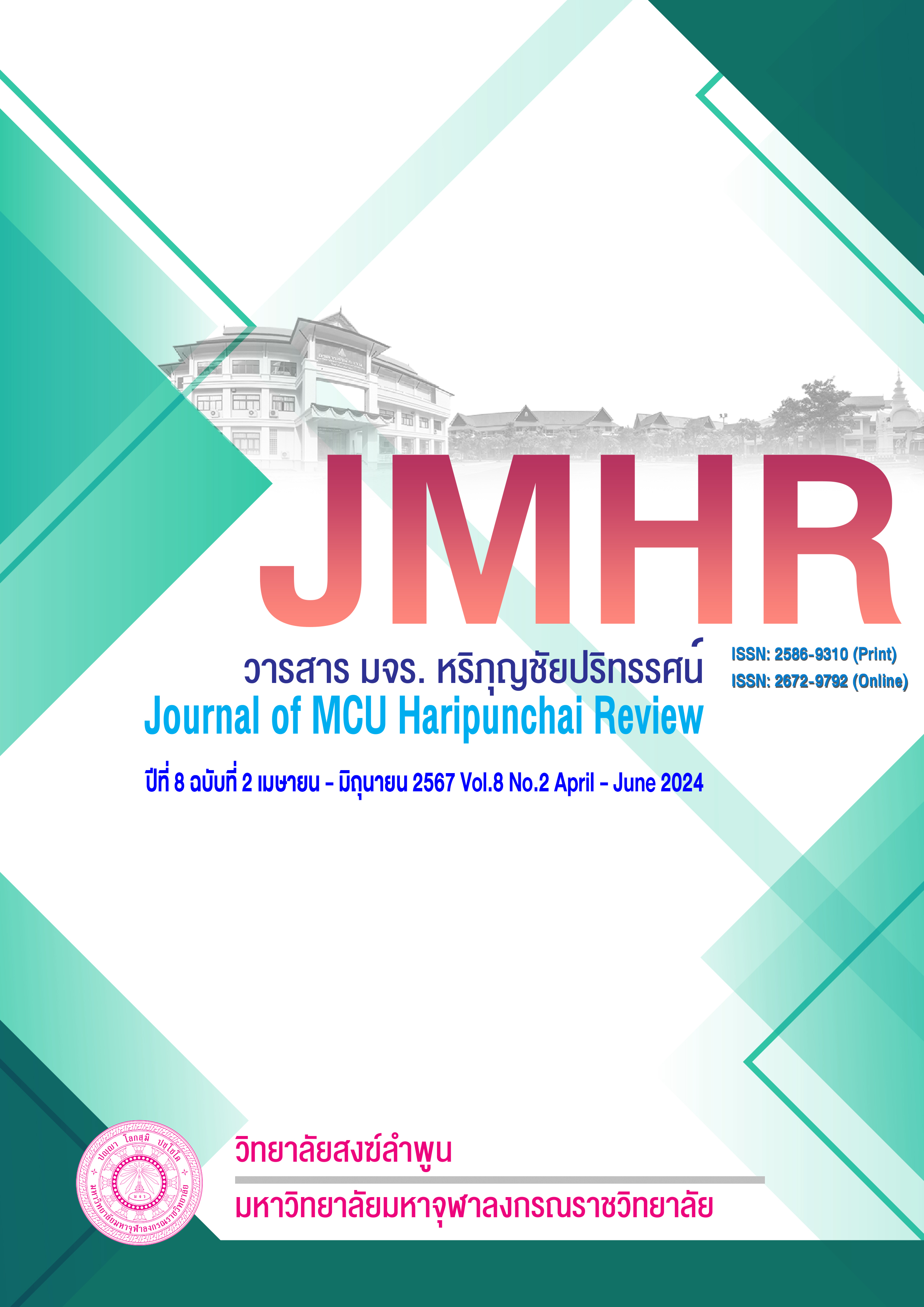An An analytical study of the environment of fully enlightened layman in Buddhism
Main Article Content
Abstract
The research study titled "An Analytical Study of the Environment of Fully Enlightened Layman in Buddhism" aims to address two main objectives: 1) to study the historical emergence of fully enlightened laymen as depicted in the Tipitaka, and 2) to analyze the environmental conditions conducive to the attainment of enlightenment among layman in Buddhism Content analysis.
The research findings reveal that
1)The process of attaining enlightenment is a cultivation of wisdom for understanding the Four Noble Truths and realizing the Dhamma. This attainment is classified into four categories: Sotapanna, Sakadagami, Anagami, and Arahat. In the time of Buddha, there were laymen who achieved these stages of enlightenment as described in the Tipitaka. Such individuals included King Suddhodana, King Bimbisara, Anathapindika, Visakha Upasika, Cittagahapati upasaka, and Ugga householder. Each individual's path to enlightenment varied based on their past and present karmic conditions and their commitment to the main principles, which include the Four Noble Truths and Samyojana principles.
2)Regarding the analysis of the environmental factors conducive to the attainment of enlightenment, it was found that the internal environment required for a layman to attain enlightenment includes abstaining from heavy karma, desire, and retribution, while cultivating saddhā, chanda, and paññā. The external environmental factors include the political and legal aspects. In the Buddha's time, there were no laws restricting religious practices, making it easier for laymen to access Buddhism. Additionally, a favorable economic environment supported the pursuit of knowledge, along with societal and cultural aspects. Despite the influence of superstitious beliefs, the Buddha aimed to reform and emphasize knowledge and conduct as determinants of one's spiritual progress, irrespective of one's lineage, caste, or place of birth. It is the combination of knowledge and conduct, the individual's way of life that enables laymen to attain enlightenment.
Article Details

This work is licensed under a Creative Commons Attribution-NonCommercial-NoDerivatives 4.0 International License.
References
ธมกร แซ่ฟอง. (2561). “ศึกษาการบรรลุธรรมของผู้อุบัติในเทวภูมิ”. วิทยานิพนธ์พุทธศาสตรมหาบัณฑิต สาขาวิชาพระพุทธศาสนา. บัณฑิตวิทยาลัย : มหาวิทยาลัยมหาจุฬาลงกรณราชวิทยาลัย.
พระธรรมปิฎก (ป.อ. ปยุตฺโต). (2540). การสร้างสรรค์ปัญญาเพื่อเพื่ออนาคตของมนุษยชาติ. พิมพ์ครั้งที่ 7. กรุงเทพมหานคร : บริษัท สหธรรมิก จำกัด.
พระธรรมปิฎก (ป.อ. ปยุตฺโต). (2545). เชื่อกรรม รู้กรรม แก้กรรม. พิมพ์ครั้งที่ 2. กรุงเทพมหานคร : สหธรรมิกจำกัด.
พระมหาไพจิตร อุตฺตมธมฺโม. (2565). “ศรัทธากับปัญญา: วิเคราะห์มุมมองในพุทธปรัชญาเถรวาท”. วารสาร มจร มนุษยศาสตร์ปริทรรศน์. ปีที่ 8 ฉบับที่ 1 (มกราคม - มิถุนายน): 462-463.
พระมหาวีรธิษณ์ วรินฺโท. (2561).“กิเลสตามหลักพระพุทธศาสนา”. วารสาร มจร บาฬีศึกษาพุทธโฆสปริทรรศน์. ปีที่ 4 ฉบับที่ 1 (มกราคม - มิถุนายน): 73.
พระมหาสมเจต สมจารี. (2559). “ศึกษาบัณเฑาะก์กับการบรรลุธรรมขั้นสูงในพุทธศาสนาเถรวาท”. วารสารศึกษาศาสตร์ มมร. ปีที่ 4 ฉบับที่ 2 (กรกฎาคม - ธันวาคม): 151-165.
พระมหาหรรษา ธมมหาโส. (2566). เศรษฐศาสตร์การเมืองเชิงพุทธ: การจัดการความขัดแย้งผ่านมิติการพัฒนาสังคมและเศรษฐกิจ. [ออนไลน์]. แหล่งที่มา : https://www.mcu.ac.th/ article/detail/440[6 สิงหาคม 2566].
มหาจุฬาลงกรณราชวิทยาลัย. (2535).พระไตรปิฎกภาษาบาลี ฉบับมหาจุฬาเตปิฏกํ 2500. กรุงเทพมหานคร: โรงพิมพ์มหาจุฬาลงกรณราชวิทยาลัย.
________. (2539). พระไตรปิฎกภาษาไทย ฉบับมหาจุฬาลงกรณราชวิทยาลัย. กรุงเทพมหานคร: โรงพิมพ์มหาจุฬาลงกรณราชวิทยาลัย.
วีระชัย ยศโสธร. (2565). “การเมืองการปกครองในแนวพระพุทธศาสนา”. วารสารวิชาการธรรมทรรศน์. ปีที่ 22 ฉบับที่ 1 (มกราคม - มีนาคม): 253 - 254.
อำนาจ ยอดทอง. (2557). “ศึกษาวิเคราะห์ความอยากในฐานเป็นบ่อเกิดของความขัดแย้ง”. วารสารสันติศึกษาปริทรรศน์ มจร. ปีที่ 3 ฉบับที่ 1 (มกราคม - กุมภาพันธ์): 5-6.


